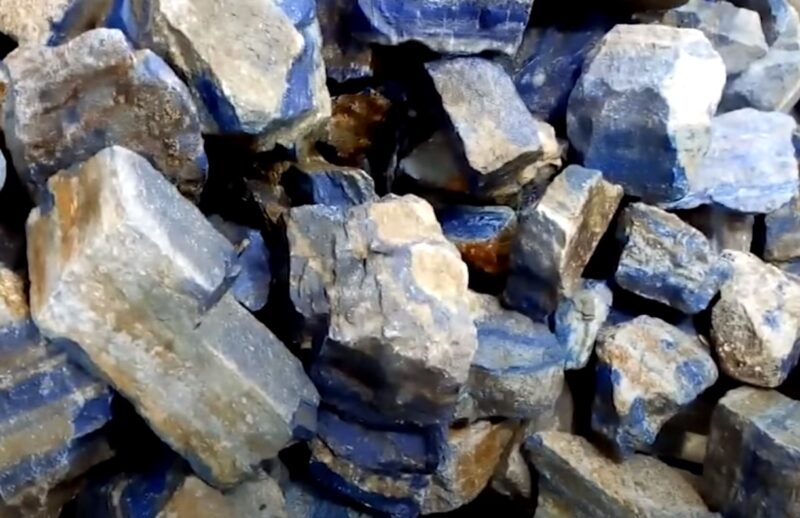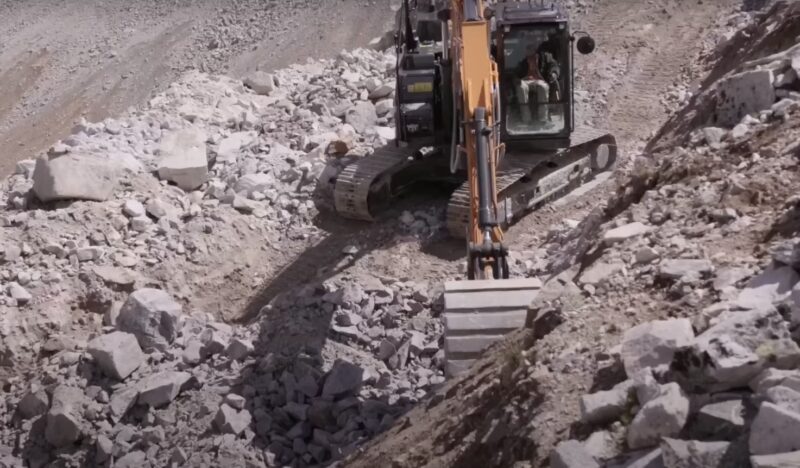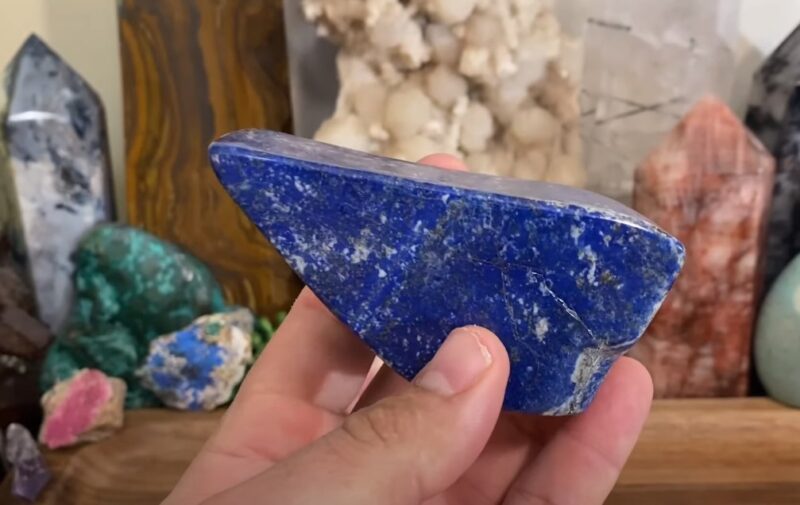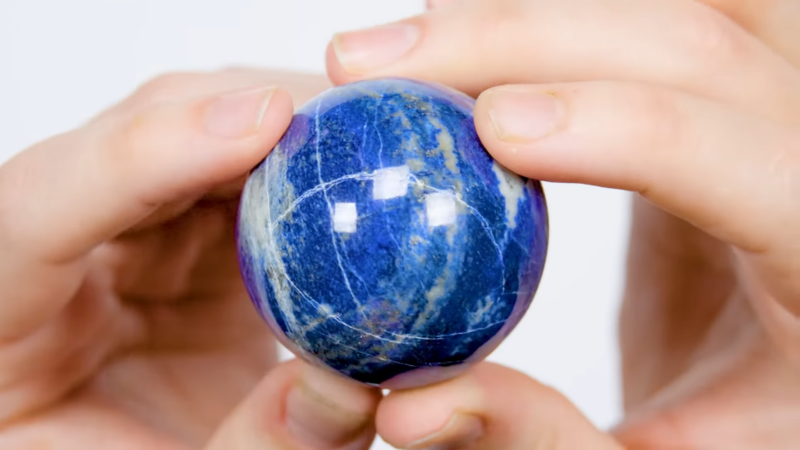Lapis lazuli, a deep blue metamorphic rock, has been valued for its intense color and used in jewelry and ornaments for centuries.
However, its beauty doesn’t negate the potential negative effects associated with its use. It is primarily composed of lazurite, but it also contains calcite, sodalite, and pyrite.
The presence of these minerals can influence the stone’s impact on both physical and environmental health.
| Feature | Description | Impact |
|---|---|---|
| Composition | Primarily composed of lazurite, with calcite, sodalite, and pyrite. | Varies based on specific mineral content. |
| Physical Properties | Softness (5-5.5 on Mohs scale), can be easily powdered. | Potential inhalation risk when powdered. |
| Respiratory Effects | Inhalation of dust during cutting or grinding. | Can cause respiratory irritation and long-term diseases like silicosis. |
| Skin Irritation | Powdered form can cause skin irritation or allergic reactions. | Direct contact can lead to dermatitis. |
| Environmental Impact | Mining leads to habitat destruction and potential chemical pollution. | Adverse effects on local ecosystems and water sources. |
| Cultural and Ethical Concerns | Importance in various cultures; issues in mining practices. | Cultural appropriation and labor exploitation. |
| Economic Impact | Significant role in local economies; subject to market volatility. | Can lead to economic instability in mining communities. |
How Serious Is the Toxicity?

Lapis lazuli itself is not inherently toxic. However, the main concern regarding toxicity arises from the inhalation of its dust, particularly when the stone is cut or powdered.
The silica content in dust can pose serious respiratory health risks, including silicosis, a potentially fatal lung disease. Therefore, while the stone in its solid form is not toxic, the process of working with it can create hazardous conditions if proper safety measures are not followed.
The seriousness of the toxicity depends on the exposure level and the form in which lapis lazuli is handled:
- Short-Term Exposure: Can cause immediate respiratory and skin irritation.
- Long-Term Exposure: Prolonged inhalation of dust can lead to chronic respiratory diseases like silicosis, which can be life-threatening.
- Skin Contact: Direct contact with lapis lazuli powder can cause dermatitis, although this is generally less severe than respiratory issues.
1. Respiratory Issues

Inhaling lapis lazuli dust, a potential hazard during cutting or engraving, can lead to serious respiratory problems. This effect stems largely from the silica content in the dust, which poses a significant health risk when inhaled.
Short-Term Exposure
Short-term exposure to lapis lazuli dust can cause respiratory irritation, leading to symptoms such as coughing and shortness of breath. This is particularly concerning in workshops or studios where the stone is frequently cut or shaped, and where dust accumulation and inhalation are more likely without proper ventilation.
Long-Term Health Risks
Chronic exposure to lapis lazuli dust can result in more severe respiratory conditions. Workers in the gemstone industry, especially those without access to appropriate protective gear and ventilation, face a heightened risk of developing silicosis.
Silicosis is a progressive lung disease caused by the inhalation of silica particles, leading to inflammation and scarring of the lung tissue. This condition can be debilitating and even fatal, emphasizing the need for stringent safety measures in workplaces handling lapis lazuli.
Preventative Measures
To mitigate these risks, implementing rigorous safety protocols is essential. Regular air quality assessments, the use of dust extraction systems, and providing workers with personal protective equipment like masks and respirators are crucial steps.
Educating workers about the risks and proper handling methods is equally important to ensure their safety and well-being.
2. Skin Irritation

Skin irritation from lapis lazuli, particularly in its powdered form, is a noteworthy concern. The calcite and pyrite content in the stone may contribute to these effects.
Direct Contact
When lapis lazuli is ground into a powder, direct contact with the skin can lead to irritation or allergic reactions. These reactions can range from mild, such as redness and itching, to more severe forms like dermatitis.
Dermatitis can manifest as swollen, reddened, and itchy skin, and in extreme cases, it can lead to blistering and peeling.
Severity and Treatment
The severity of skin reactions can vary based on individual sensitivity and the duration of exposure. Treatment typically involves avoiding further contact with the irritant and using topical medications like corticosteroids to reduce inflammation and soothe the skin.
In cases of severe allergic reactions, medical consultation is advised for appropriate treatment.
Preventive Measures
Preventive measures include wearing protective gloves when handling powdered lapis lazuli and ensuring good hygiene practices, such as thoroughly washing hands after contact. In industrial settings, minimizing the generation of dust and providing appropriate protective gear are essential.
3. Impact on the Environment

The environmental impact of mining and processing lapis lazuli is a significant concern.
Habitat Destruction
Lapis lazuli mining often involves large-scale operations that can lead to the destruction of natural habitats. This destruction disrupts local ecosystems, leading to loss of biodiversity and long-term ecological imbalances.
The visual and physical alteration of landscapes can also have profound effects on local communities, affecting their way of life and access to natural resources.
Pollution and Waste
The mining process generates a considerable amount of waste, including rock debris and chemical pollutants. These pollutants can contaminate soil and water sources, posing risks to wildlife and human populations in the vicinity.
The chemicals used in processing lapis lazuli, such as acids and heavy metals, can further exacerbate this environmental degradation.
Sustainable Practices
To mitigate these environmental issues, adopting sustainable mining practices is crucial. This includes minimizing land disturbance, implementing waste management strategies, and using eco-friendly processing techniques.
Regulatory bodies and industry stakeholders must collaborate to enforce environmental protection measures and promote responsible mining practices.
4. Cultural and Ethical Concerns
The extraction and trade of lapis lazuli are not just environmental and health issues; they also encompass cultural and ethical dimensions.
Cultural Appropriation
Lapis lazuli holds significant cultural and historical value in various societies, and its commercialization can sometimes lead to cultural appropriation.
This occurs when the cultural significance of the stone is either overlooked or exploited for profit, without respect for its traditional meanings and uses.
Such appropriation can lead to the erosion of cultural heritage and the alienation of communities that hold the stone in high regard.
Ethical Mining
The ethical concerns in lapis lazuli mining include labor exploitation and unsafe working conditions. Miners often work in hazardous environments without adequate safety measures, leading to health risks and accidents.
Additionally, the economic benefits of mining are not always equitably distributed, with local communities frequently receiving minimal compensation. We can see similar problems with diamond mines.
If you don’t have enough experience, it is important to learn more about the differences between raw diamonds and this gem because the appearance is not the only one.
Ethical Practices are Essential
Addressing these concerns involves promoting ethical mining practices and respecting the cultural significance of lapis lazuli. Consumers can play a role by seeking ethically sourced stones and supporting initiatives that ensure fair compensation and safe working conditions for miners.
Raising awareness about the cultural importance of lapis lazuli and advocating for responsible trade practices are also crucial in addressing these ethical challenges.
5. Economic Impact

The lapis lazuli trade has both positive and negative economic impacts, which are important to consider.
Local Economies
In areas where lapis lazuli is mined, the industry can significantly boost local economies by providing employment opportunities and stimulating economic growth.
However, this dependence can also make these regions vulnerable to fluctuations in the global gemstone market. Changes in demand or price can have immediate and profound effects on the livelihoods of those involved in the mining and trade of lapis lazuli.
Market Volatility
The value of lapis lazuli is subject to market volatility, influenced by factors such as fashion trends, global economic conditions, and competition from synthetic alternatives. This volatility can impact miners and traders, leading to financial instability and uncertainty.
Sustainable Economic Development
To address these economic challenges, it is essential to develop sustainable economic models around lapis lazuli mining. This includes supporting community-based projects that ensure fair wages and working conditions, and promoting fair trade practices.
Diversifying the local economy and reducing dependence on a single commodity can also help stabilize these regions economically.
FAQs
Can wearing lapis lazuli jewelry cause allergic reactions?
While lapis lazuli itself is generally safe to wear, some individuals may experience allergic reactions, especially if they have sensitive skin. This can be due to the metal used in the jewelry setting, rather than the stone itself. It’s rare for lapis lazuli to cause skin allergies, but if you experience any irritation, it’s advisable to consult with a dermatologist.
Are there any precautions to take when storing lapis lazuli?
Lapis lazuli should be stored away from direct sunlight and high temperatures, as prolonged exposure can fade its color. It’s also a relatively soft stone, so storing it separately from harder gemstones will prevent scratches. Using a soft cloth pouch or a padded jewelry box is recommended for storage.
Can lapis lazuli be safely cleaned at home?
Yes, lapis lazuli can be cleaned at home, but with care. Use lukewarm water and mild soap, gently wiping the stone with a soft cloth. Avoid using harsh chemicals or ultrasonic cleaners, as these can damage the stone. After cleaning, dry it thoroughly with a soft cloth.
How does the quality of lapis lazuli affect its potential health risks?
The quality of lapis lazuli itself does not directly affect its potential health risks. The risks are more related to how the stone is processed, particularly when it’s ground into powder. High-quality or low-quality, the precautions remain the same regarding dust inhalation and skin contact.
Summary
While lapis lazuli is undoubtedly a beautiful and valuable gemstone, its negative effects—ranging from health risks to environmental, cultural, ethical, and economic concerns—cannot be overlooked.
Understanding and addressing these issues is crucial for consumers, industry professionals, and policymakers to ensure responsible and sustainable practices in the lapis lazuli trade.
